Patterns of Cough Medication Prescribing among Patients with Chronic Cough in Florida: 2012–2021
Abstract
:1. Introduction
2. Materials and Methods
2.1. Data Source
2.2. Study Design and Population
2.3. Outcomes of Interest
2.4. Covariates
2.5. Statistical Analysis
2.6. Secondary Analyses
3. Results
3.1. Repeated Cross-Sectional Analyses: 2012–2021 OneFlorida Data
3.1.1. Trends in Annual CM Prescribing Prevalence in CC Patients
3.1.2. Trends in Annual CM Prescribing Prevalence in Non-CC Patients with Any Cough-Related Diagnosis
3.2. GBTM Analysis: 2012–2021 OneFlorida Data
3.2.1. Distinct CM Utilization Trajectories Identified in CC Patients and Non-CC Patients with Any Cough-Related Diagnosis
3.2.2. Pre-Index Characteristics of CC Patients and Non-CC Patients with Any Cough-Related Diagnosis
3.2.3. Post-Index Characteristics of CC Patients and Non-CC Patients with Any Cough-Related Diagnosis
3.2.4. Pre-Index Factors Associated with CM Utilization Trajectories in CC Patients
3.3. Secondary Analyses
4. Discussion
5. Conclusions
Supplementary Materials
Author Contributions
Funding
Institutional Review Board Statement
Informed Consent Statement
Data Availability Statement
Conflicts of Interest
References
- Irwin, R.S.; Baumann, M.H.; Bolser, D.C.; Boulet, L.P.; Braman, S.S.; Brightling, C.E.; Brown, K.K.; Canning, B.J.; Chang, A.B.; Dicpinigaitis, P.V.; et al. Diagnosis and management of cough executive summary: ACCP evidence-based clinical practice guidelines. Chest 2006, 129, 1S–23S. [Google Scholar] [CrossRef] [PubMed]
- Koskela, H.O.; Latti, A.M.; Pekkanen, J. The impacts of cough: A cross-sectional study in a Finnish adult employee population. ERJ Open Res. 2018, 4, 00113-2018. [Google Scholar] [CrossRef]
- French, C.L.; Irwin, R.S.; Curley, F.J.; Krikorian, C.J. Impact of chronic cough on quality of life. Arch. Intern. Med. 1998, 158, 1657–1661. [Google Scholar] [CrossRef] [PubMed]
- Chamberlain, S.A.; Garrod, R.; Douiri, A.; Masefield, S.; Powell, P.; Bucher, C.; Pandyan, A.; Morice, A.H.; Birring, S.S. The impact of chronic cough: A cross-sectional European survey. Lung 2015, 193, 401–408. [Google Scholar] [CrossRef]
- Song, W.J.; Chang, Y.S.; Faruqi, S.; Kim, J.Y.; Kang, M.G.; Kim, S.; Jo, E.J.; Kim, M.H.; Plevkova, J.; Park, H.W.; et al. The global epidemiology of chronic cough in adults: A systematic review and meta-analysis. Eur. Respir. J. 2015, 45, 1479–1481. [Google Scholar] [CrossRef]
- Meltzer, E.O.; Zeiger, R.S.; Dicpinigaitis, P.; Bernstein, J.A.; Oppenheimer, J.J.; Way, N.A.; Li, V.W.; Boggs, R.; Doane, M.J.; Urdaneta, E.; et al. Prevalence and Burden of Chronic Cough in the United States. J. Allergy Clin. Immunol. Pract. 2021, 9, 4037–4044.e4032. [Google Scholar] [CrossRef] [PubMed]
- McGarvey, L.; Rubin, B.K.; Ebihara, S.; Hegland, K.; Rivet, A.; Irwin, R.S.; Bolser, D.C.; Chang, A.B.; Gibson, P.G.; Mazzone, S.B.; et al. Global Physiology and Pathophysiology of Cough: Part 2. Demographic and Clinical Considerations: CHEST Expert Panel Report. Chest 2021, 160, 1413–1423. [Google Scholar] [CrossRef]
- Pratter, M.R. Overview of common causes of chronic cough: ACCP evidence-based clinical practice guidelines. Chest 2006, 129, 59S–62S. [Google Scholar] [CrossRef]
- Sandage, M.J.; Ostwalt, E.S.; Allison, L.H.; Cutchin, G.M.; Morton, M.E.; Odom, S.C. Irritant-Induced Chronic Cough Triggers: A Scoping Review and Clinical Checklist. Am. J. Speech Lang. Pathol. 2021, 30, 1261–1291. [Google Scholar] [CrossRef]
- Zhang, J.; Perret, J.L.; Chang, A.B.; Idrose, N.S.; Bui, D.S.; Lowe, A.J.; Abramson, M.J.; Walters, E.H.; Lodge, C.J.; Dharmage, S.C. Risk factors for chronic cough in adults: A systematic review and meta-analysis. Respirology 2022, 27, 36–47. [Google Scholar] [CrossRef] [PubMed]
- Irwin, R.S.; French, C.L.; Chang, A.B.; Altman, K.W.; Panel, C.E.C. Classification of Cough as a Symptom in Adults and Management Algorithms: CHEST Guideline and Expert Panel Report. Chest 2018, 153, 196–209. [Google Scholar] [CrossRef] [PubMed]
- Smith, J.A.; Woodcock, A. Chronic Cough. N. Engl. J. Med. 2016, 375, 1544–1551. [Google Scholar] [CrossRef] [PubMed]
- Vertigan, A.E.; Gibson, P.G. Chronic refractory cough as a sensory neuropathy: Evidence from a reinterpretation of cough triggers. J. Voice 2011, 25, 596–601. [Google Scholar] [CrossRef] [PubMed]
- Song, W.J.; Kim, J.Y.; Jo, E.J.; Lee, S.E.; Kim, M.H.; Yang, M.S.; Kang, H.R.; Park, H.W.; Chang, Y.S.; Min, K.U.; et al. Capsaicin cough sensitivity is related to the older female predominant feature in chronic cough patients. Allergy Asthma Immunol. Res. 2014, 6, 401–408. [Google Scholar] [CrossRef] [PubMed]
- Morice, A.H.; Millqvist, E.; Belvisi, M.G.; Bieksiene, K.; Birring, S.S.; Chung, K.F.; Dal Negro, R.W.; Dicpinigaitis, P.; Kantar, A.; McGarvey, L.P.; et al. Expert opinion on the cough hypersensitivity syndrome in respiratory medicine. Eur. Respir. J. 2014, 44, 1132–1148. [Google Scholar] [CrossRef]
- Vertigan, A.E.; Kapela, S.L.; Ryan, N.M.; Birring, S.S.; McElduff, P.; Gibson, P.G. Pregabalin and Speech Pathology Combination Therapy for Refractory Chronic Cough: A Randomized Controlled Trial. Chest 2016, 149, 639–648. [Google Scholar] [CrossRef]
- Ryan, N.M.; Birring, S.S.; Gibson, P.G. Gabapentin for refractory chronic cough: A randomised, double-blind, placebo-controlled trial. Lancet 2012, 380, 1583–1589. [Google Scholar] [CrossRef]
- Morice, A.H.; Menon, M.S.; Mulrennan, S.A.; Everett, C.F.; Wright, C.; Jackson, J.; Thompson, R. Opiate therapy in chronic cough. Am. J. Respir. Crit. Care Med. 2007, 175, 312–315. [Google Scholar] [CrossRef]
- Jeyakumar, A.; Brickman, T.M.; Haben, M. Effectiveness of amitriptyline versus cough suppressants in the treatment of chronic cough resulting from postviral vagal neuropathy. Laryngoscope 2006, 116, 2108–2112. [Google Scholar] [CrossRef]
- Gibson, P.; Wang, G.; McGarvey, L.; Vertigan, A.E.; Altman, K.W.; Birring, S.S.; Panel, C.E.C. Treatment of Unexplained Chronic Cough: CHEST Guideline and Expert Panel Report. Chest 2016, 149, 27–44. [Google Scholar] [CrossRef]
- OneFlorida Clinical Research Consortium. Available online: https://www.ctsi.ufl.edu/ctsa-consortium-projects/oneflorida/ (accessed on 22 June 2021).
- Hogan, W.R.; Shenkman, E.A.; Robinson, T.; Carasquillo, O.; Robinson, P.S.; Essner, R.Z.; Bian, J.; Lipori, G.; Harle, C.; Magoc, T.; et al. The OneFlorida Data Trust: A centralized, translational research data infrastructure of statewide scope. J. Am. Med. Inform. Assoc. 2022, 29, 686–693. [Google Scholar] [CrossRef] [PubMed]
- Fleurence, R.L.; Curtis, L.H.; Califf, R.M.; Platt, R.; Selby, J.V.; Brown, J.S. Launching PCORnet, a national patient-centered clinical research network. J. Am. Med. Inform. Assoc. 2014, 21, 578–582. [Google Scholar] [CrossRef] [PubMed]
- Bali, V.W.J.; Turzhitsky, V.; Schelfhout, J.; Paudel, M.; Hulbert, E.; Peterson-Brandt, J.; Hertzberg, J.; Kelly, N.R.; Patel, R.H. Development of a Claims-Based Algorithm to Identify Patients with Chronic Cough. Am. J. Respir. Crit. Care Med. 2021, 203, A3146. [Google Scholar] [CrossRef]
- Weiner, M.; Dexter, P.R.; Heithoff, K.; Roberts, A.R.; Liu, Z.; Griffith, A.; Hui, S.; Schelfhout, J.; Dicpinigaitis, P.; Doshi, I.; et al. Identifying and Characterizing a Chronic Cough Cohort Through Electronic Health Records. Chest 2021, 159, 2346–2355. [Google Scholar] [CrossRef]
- Bali, V.; Weaver, J.; Turzhitsky, V.; Schelfhout, J.; Paudel, M.L.; Hulbert, E.; Peterson-Brandt, J.; Currie, A.G.; Bakka, D. Development of a natural language processing algorithm to detect chronic cough in electronic health records. BMC Pulm. Med. 2022, 22, 256. [Google Scholar] [CrossRef]
- Zeiger, R.S.; Xie, F.; Schatz, M.; Hong, B.D.; Weaver, J.P.; Bali, V.; Schelfhout, J.; Chen, W. Prevalence and Characteristics of Chronic Cough in Adults Identified by Administrative Data. Perm. J. 2020, 24, 1–3. [Google Scholar] [CrossRef]
- Zhou, L.; Bhattacharjee, S.; Kwoh, C.K.; Tighe, P.J.; Malone, D.C.; Slack, M.; Wilson, D.L.; Brown, J.D.; Lo-Ciganic, W.H. Trends, Patient and Prescriber Characteristics in Gabapentinoid Use in a Sample of United States Ambulatory Care Visits from 2003 to 2016. J. Clin. Med. 2019, 9, 83. [Google Scholar] [CrossRef]
- Dowell, D.; Ragan, K.R.; Jones, C.M.; Baldwin, G.T.; Chou, R. CDC Clinical Practice Guideline for Prescribing Opioids for Pain-United States, 2022. MMWR Recomm Rep. 2022, 71, 1. [Google Scholar] [CrossRef]
- Meara, E.; Horwitz, J.R.; Powell, W.; McClelland, L.; Zhou, W.; O’Malley, A.J.; Morden, N.E. State Legal Restrictions and Prescription-Opioid Use among Disabled Adults. N. Engl. J. Med. 2016, 375, 44–53. [Google Scholar] [CrossRef]
- The National Patient-Centered Clinical Research Network. Common Data Model (CDM) Specification, Version 6.0. Available online: https://pcornet.org/wp-content/uploads/2022/01/PCORnet-Common-Data-Model-v60-2020_10_221.pdf (accessed on 5 December 2022).
- Elixhauser, A.; Steiner, C.; Harris, D.R.; Coffey, R.M. Comorbidity measures for use with administrative data. Med. Care 1998, 36, 8–27. [Google Scholar] [CrossRef]
- National Committee for Quality Assurance. HEDIS Measures and Technical Resources. HEDIS MY 2021 Medication List. Directory. Available online: https://www.ncqa.org/hedis/measures/ (accessed on 5 December 2022).
- Jones, B.L.; Nagin, D.S. Advances in Group-Based Trajectory Modeling and an SAS Procedure for Estimating Them. Sociol. Methods Res. 2007, 35, 542–571. [Google Scholar] [CrossRef]
- Nagin, D.S.; Jones, B.L.; Passos, V.L.; Tremblay, R.E. Group-based multi-trajectory modeling. Stat. Methods Med. Res. 2018, 27, 2015–2023. [Google Scholar] [CrossRef]
- Nagin, D.S.; Odgers, C.L. Group-based trajectory modeling in clinical research. Annu. Rev. Clin. Psychol. 2010, 6, 109–138. [Google Scholar] [CrossRef]
- Nagin, D.S. Group-Based Modeling of Development; Harvard University Press: Cambridge, MA, USA, 2005. [Google Scholar]
- Twisk, J.; Hoekstra, T. Classifying developmental trajectories over time should be done with great caution: A comparison between methods. J. Clin. Epidemiol. 2012, 65, 1078–1087. [Google Scholar] [CrossRef] [PubMed]
- Yang, S.; Hincapie-Castillo, J.M.; Ke, X.; Schelfhout, J.; Ding, H.; Sher, M.R.; Zhou, L.; Chang, C.Y.; Wilson, D.L.; Lo-Ciganic, W.H. Evaluation of Cough Medication Use Patterns in Ambulatory Care Settings in the United States: 2003–2018. J. Clin. Med. 2022, 11, 3671. [Google Scholar] [CrossRef]
- Kim, I.; Goulding, M.; Tian, F.; Karami, S.; Pham, T.; Cheng, C.; Biehl, A.; Munoz, M. Benzonatate Exposure Trends and Adverse Events. Pediatrics 2022, 150, e2022057779. [Google Scholar] [CrossRef]
- Smith, R.V.; Lofwall, M.R.; Havens, J.R. Abuse and diversion of gabapentin among nonmedical prescription opioid users in Appalachian Kentucky. Am. J. Psychiatry 2015, 172, 487–488. [Google Scholar] [CrossRef]
- Smith, R.V.; Havens, J.R.; Walsh, S.L. Gabapentin misuse, abuse and diversion: A systematic review. Addiction 2016, 111, 1160–1174. [Google Scholar] [CrossRef] [PubMed]
- Radley, D.C.; Finkelstein, S.N.; Stafford, R.S. Off-label prescribing among office-based physicians. Arch. Intern. Med. 2006, 166, 1021–1026. [Google Scholar] [CrossRef]
- Buttram, M.E.; Kurtz, S.P.; Dart, R.C.; Margolin, Z.R. Law enforcement-derived data on gabapentin diversion and misuse, 2002–2015: Diversion rates and qualitative research findings. Pharmacoepidemiol. Drug Saf. 2017, 26, 1083–1086. [Google Scholar] [CrossRef]
- Bonnet, U.; Scherbaum, N. How addictive are gabapentin and pregabalin? A systematic review. Eur. Neuropsychopharmacol. 2017, 27, 1185–1215. [Google Scholar] [CrossRef]
- National Center for Immunization and Respiratory Diseases (NCIRD), Division of Viral Diseases. Symptoms of COVID-19. Available online: https://www.cdc.gov/coronavirus/2019-ncov/symptoms-testing/symptoms.html (accessed on 5 December 2022).
- Colak, Y.; Nordestgaard, B.G.; Laursen, L.C.; Afzal, S.; Lange, P.; Dahl, M. Risk Factors for Chronic Cough Among 14,669 Individuals From the General Population. Chest 2017, 152, 563–573. [Google Scholar] [CrossRef] [PubMed]
- Won, H.K.; Kang, S.Y.; Kang, Y.; An, J.; Lee, J.H.; Lee, S.M.; Kwon, J.W.; Kim, M.H.; Jo, E.J.; Lee, S.E.; et al. Cough-Related Laryngeal Sensations and Triggers in Adults With Chronic Cough: Symptom Profile and Impact. Allergy Asthma Immunol. Res. 2019, 11, 622–631. [Google Scholar] [CrossRef] [PubMed]
- Hilton, E.; Marsden, P.; Thurston, A.; Kennedy, S.; Decalmer, S.; Smith, J.A. Clinical features of the urge-to-cough in patients with chronic cough. Respir. Med. 2015, 109, 701–707. [Google Scholar] [CrossRef] [PubMed]
- Arinze, J.T.; Verhamme, K.M.C.; Luik, A.I.; Stricker, B.; van Meurs, J.B.J.; Brusselle, G.G. The interrelatedness of chronic cough and chronic pain. Eur. Respir. J. 2021, 57, 2002651. [Google Scholar] [CrossRef]
- Arinze, J.T.; Hofman, A.; de Roos, E.W.; de Ridder, M.A.J.; Verhamme, K.M.C.; Stricker, B.; Brusselle, G.G.; Luik, A.I. The interrelationship of chronic cough and depression: A prospective population-based study. ERJ Open Res. 2022, 8, 00069-2022. [Google Scholar] [CrossRef]
- Sohn, K.H.; Song, W.J.; Kim, S.H.; Jang, H.C.; Kim, K.W.; Chang, Y.S. Chronic cough, not asthma, is associated with depression in the elderly: A community-based population analysis in South Korea. Korean J. Intern. Med. 2019, 34, 1363–1371. [Google Scholar] [CrossRef]
- Won, H.K.; Lee, J.H.; An, J.; Sohn, K.H.; Kang, M.G.; Kang, S.Y.; Morice, A.H.; Cho, S.H.; Song, W.J. Impact of Chronic Cough on Health-Related Quality of Life in the Korean Adult General Population: The Korean National Health and Nutrition Examination Survey 2010–2016. Allergy Asthma Immunol. Res. 2020, 12, 964–979. [Google Scholar] [CrossRef]
- Kardos, P.; Blaiss, M.; Dicpinigaitis, P. Addressing unmet needs for diagnosis and management of chronic cough in the primary care setting. Postgrad. Med. 2021, 133, 481–488. [Google Scholar] [CrossRef]
- Rouadi, P.W.; Idriss, S.A.; Bousquet, J.; Laidlaw, T.M.; Azar, C.R.; Al-Ahmad, M.S.; Yanez, A.; Al-Nesf, M.A.Y.; Nsouli, T.M.; Bahna, S.L.; et al. WAO-ARIA consensus on chronic cough-Part III: Management strategies in primary and cough-specialty care. Updates in COVID-19. World Allergy Organ. J. 2022, 15, 100649. [Google Scholar] [CrossRef]
- Puente-Maestu, L.; Molina-Paris, J.; Trigueros, J.A.; Gomez-Saenz, J.T.; Cea-Calvo, L.; Fernandez, S.; Sanchez-Jareno, M.; Dominguez-Ortega, J. A Survey of Physicians’ Perception of the Use and Effectiveness of Diagnostic and Therapeutic Procedures in Chronic Cough Patients. Lung 2021, 199, 507–515. [Google Scholar] [CrossRef] [PubMed]
- Leuppi, J.D.; Guggisberg, P.; Koch, D.; Favre-Bulle, A.; Fabiani, M.; Heinz, S.; Zeller, A. Understanding physician’s knowledge and perception of chronic cough in Switzerland. Curr. Med. Res. Opin. 2022, 38, 1459–1466. [Google Scholar] [CrossRef]
- Kum, E.; Brister, D.; Diab, N.; Wahab, M.; Abraham, T.; Sahakian, S.; Qureshy, K.; Hernandez, P.; Kim, H.; Cormier, M.; et al. Canadian Health Care Professionals’ Familiarity with Chronic Cough Guidelines and Experiences with Diagnosis and Management: A Cross-Sectional Survey. Lung 2023, 201, 47–55. [Google Scholar] [CrossRef] [PubMed]
- Hull, J.H.; Langerman, H.; Ul-Haq, Z.; Kamalati, T.; Lucas, A.; Levy, M.L. Burden and impact of chronic cough in UK primary care: A dataset analysis. BMJ Open 2021, 11, e054832. [Google Scholar] [CrossRef] [PubMed]
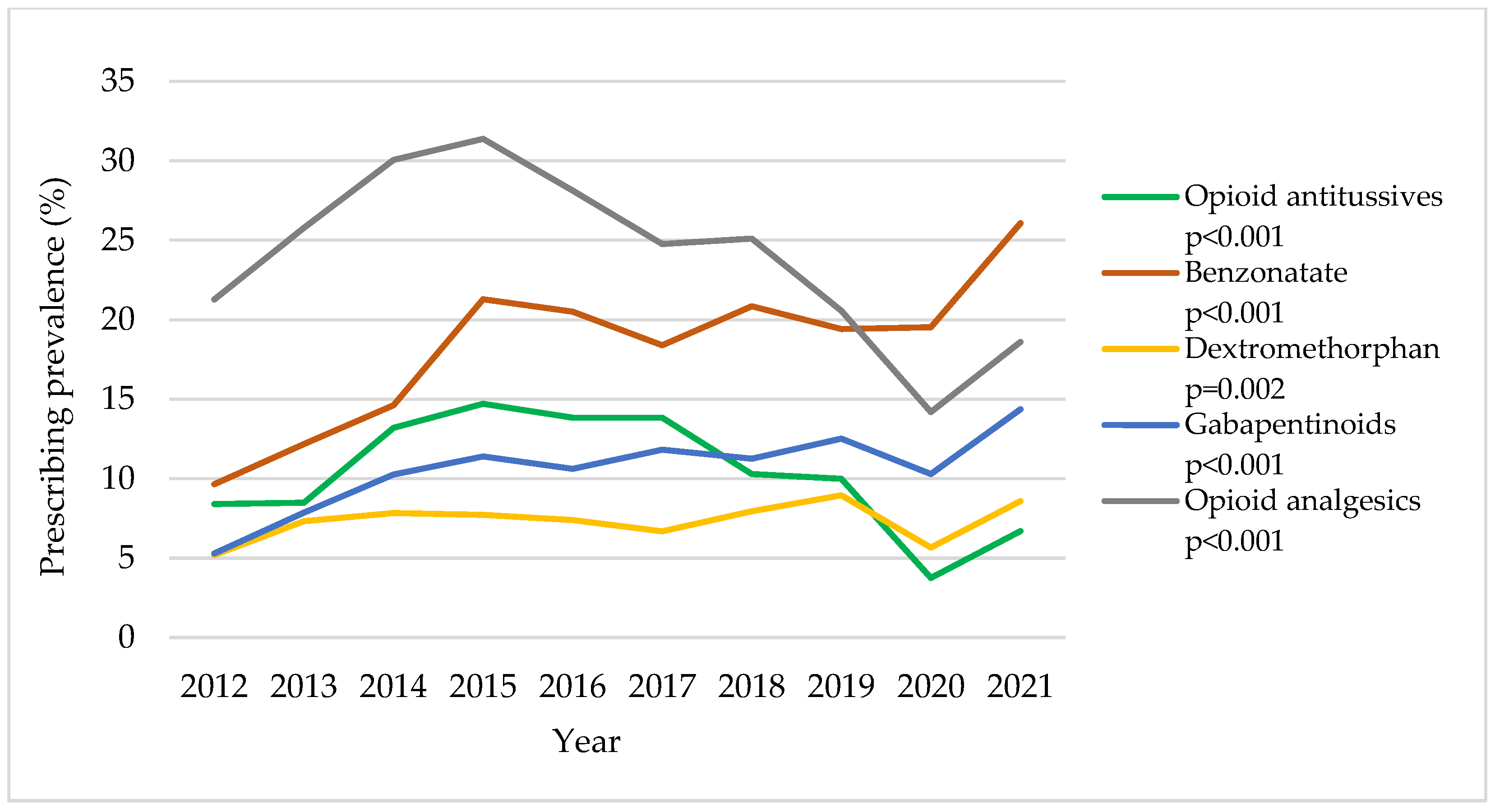
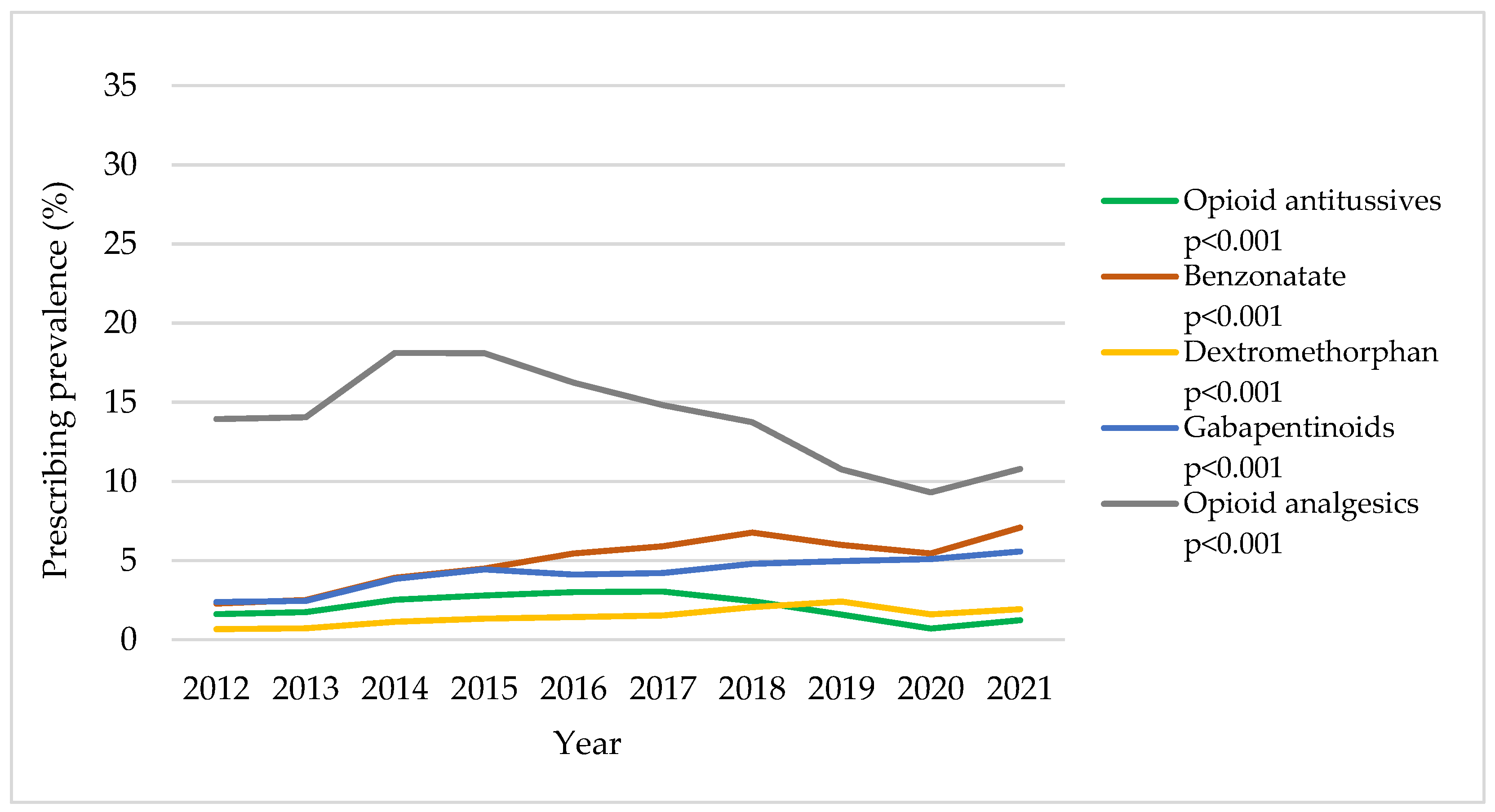
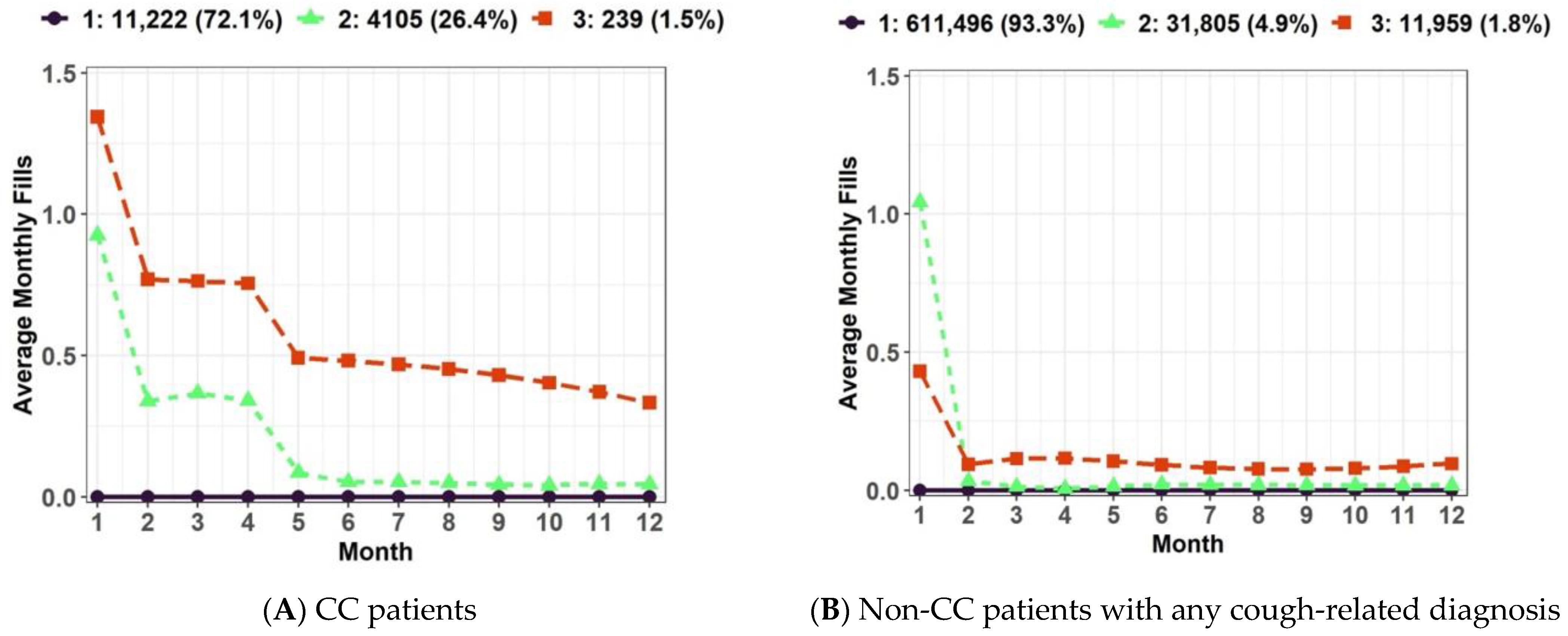
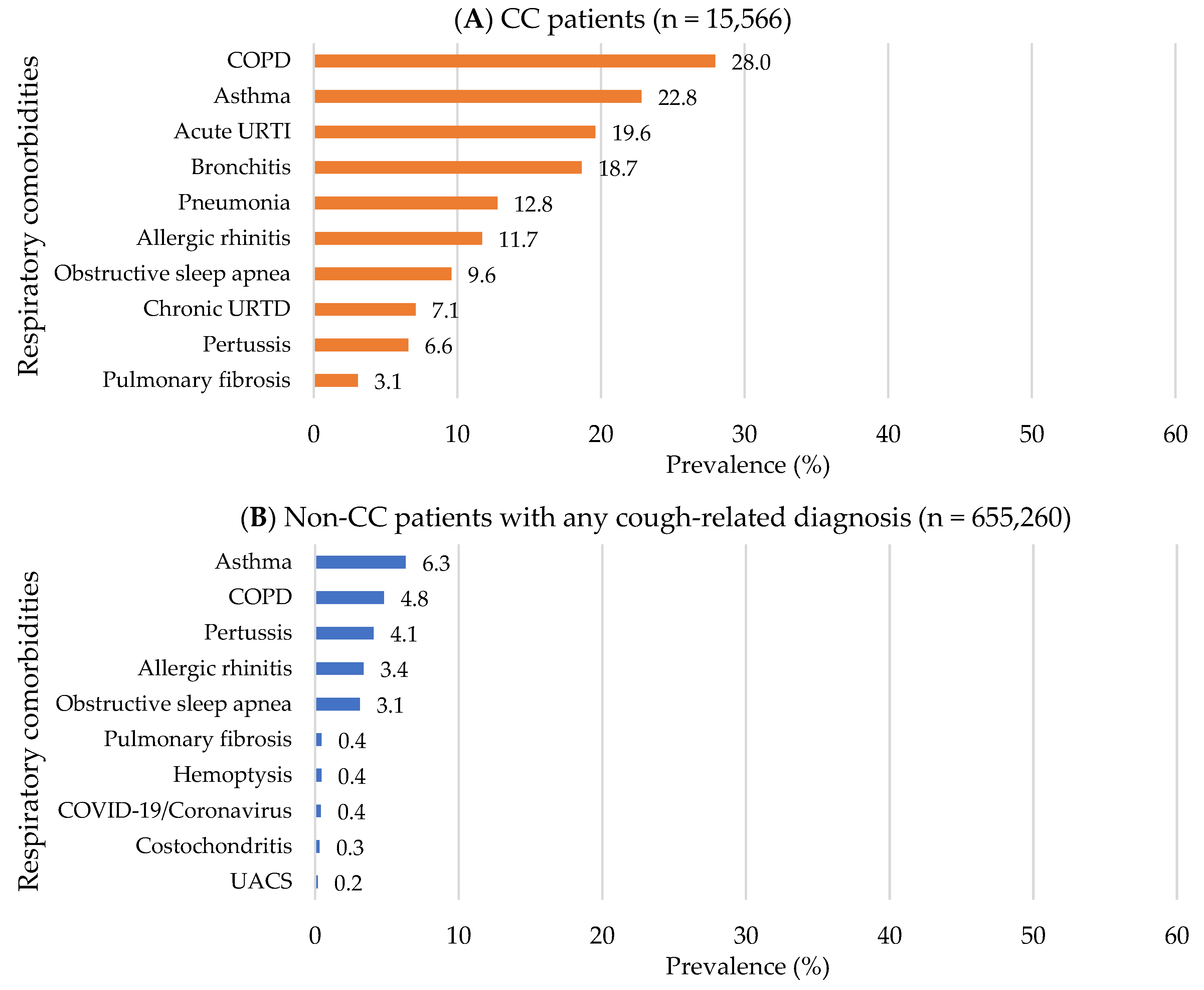
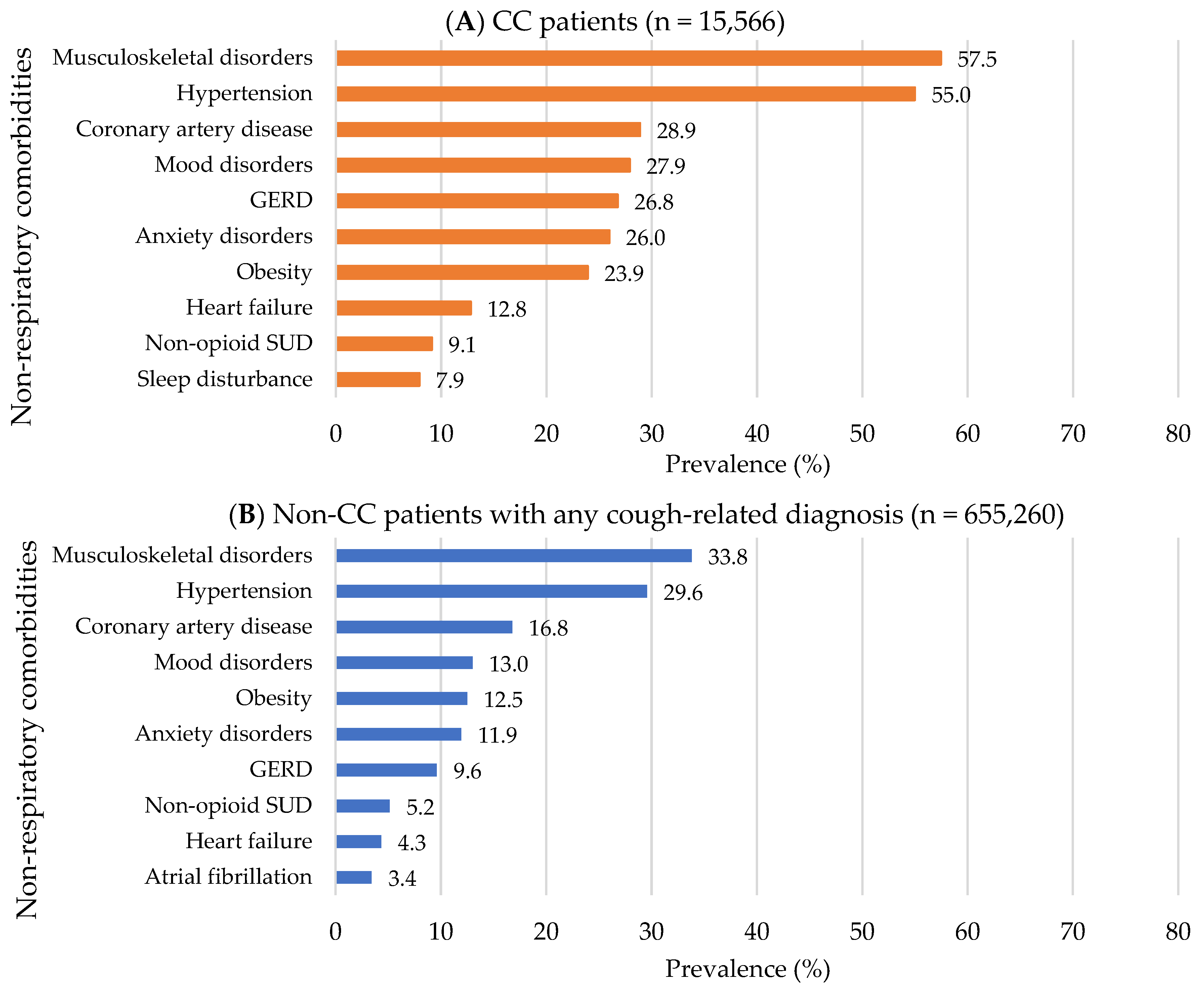
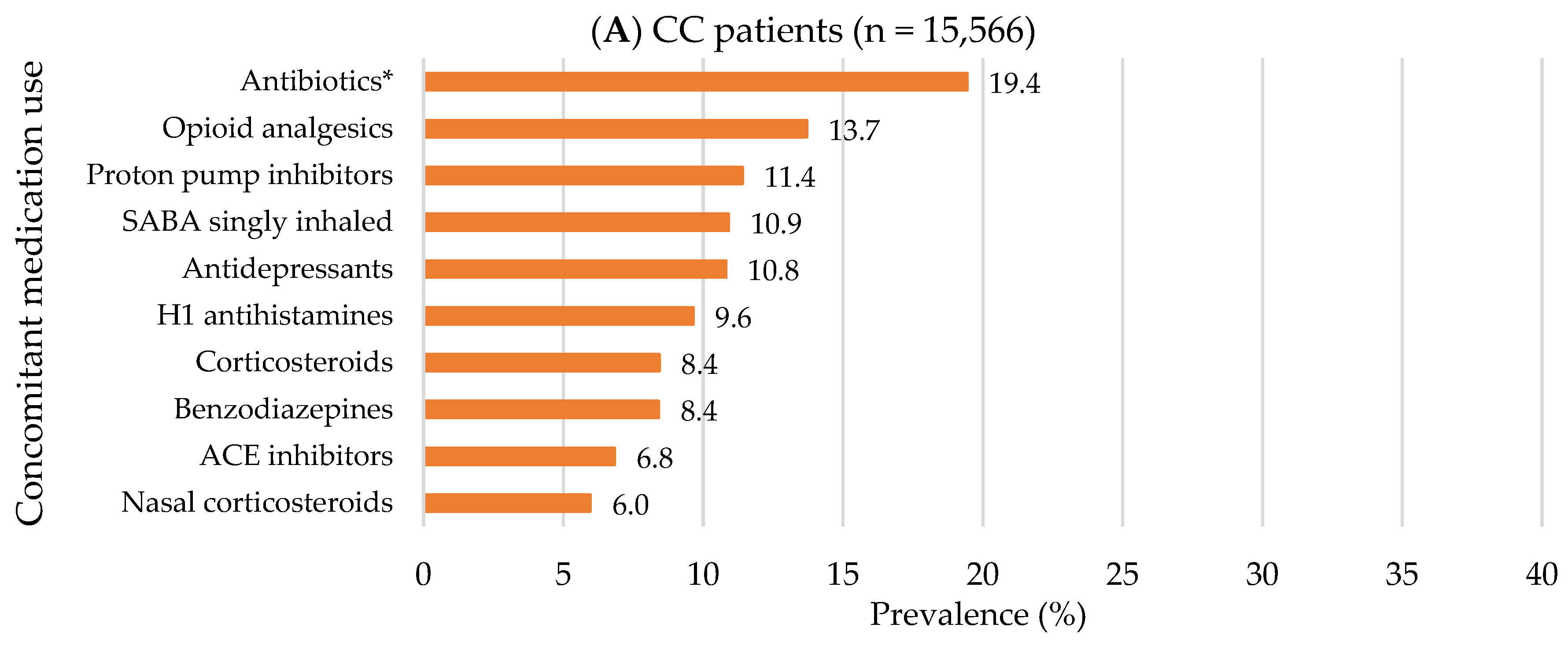
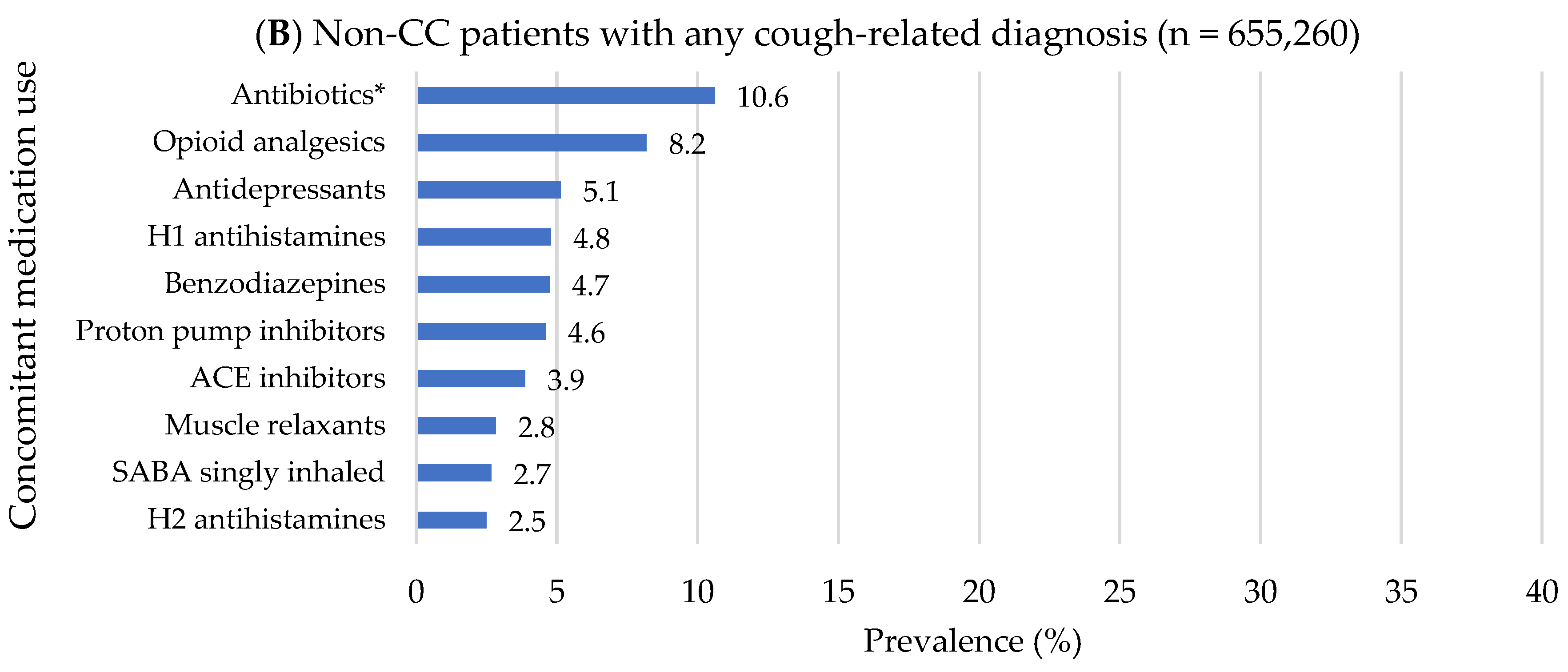
Disclaimer/Publisher’s Note: The statements, opinions and data contained in all publications are solely those of the individual author(s) and contributor(s) and not of MDPI and/or the editor(s). MDPI and/or the editor(s) disclaim responsibility for any injury to people or property resulting from any ideas, methods, instructions or products referred to in the content. |
© 2023 by the authors. Licensee MDPI, Basel, Switzerland. This article is an open access article distributed under the terms and conditions of the Creative Commons Attribution (CC BY) license (https://creativecommons.org/licenses/by/4.0/).
Share and Cite
Yang, S.; Huang, S.; Hincapie-Castillo, J.M.; Ke, X.; Ding, H.; Schelfhout, J.; Sher, M.R.; Jones, B.; Wilson, D.L.; Lo-Ciganic, W.-H. Patterns of Cough Medication Prescribing among Patients with Chronic Cough in Florida: 2012–2021. J. Clin. Med. 2023, 12, 6286. https://doi.org/10.3390/jcm12196286
Yang S, Huang S, Hincapie-Castillo JM, Ke X, Ding H, Schelfhout J, Sher MR, Jones B, Wilson DL, Lo-Ciganic W-H. Patterns of Cough Medication Prescribing among Patients with Chronic Cough in Florida: 2012–2021. Journal of Clinical Medicine. 2023; 12(19):6286. https://doi.org/10.3390/jcm12196286
Chicago/Turabian StyleYang, Seonkyeong, Shu Huang, Juan M. Hincapie-Castillo, Xuehua Ke, Helen Ding, Jonathan Schelfhout, Mandel R. Sher, Bobby Jones, Debbie L. Wilson, and Wei-Hsuan Lo-Ciganic. 2023. "Patterns of Cough Medication Prescribing among Patients with Chronic Cough in Florida: 2012–2021" Journal of Clinical Medicine 12, no. 19: 6286. https://doi.org/10.3390/jcm12196286
APA StyleYang, S., Huang, S., Hincapie-Castillo, J. M., Ke, X., Ding, H., Schelfhout, J., Sher, M. R., Jones, B., Wilson, D. L., & Lo-Ciganic, W.-H. (2023). Patterns of Cough Medication Prescribing among Patients with Chronic Cough in Florida: 2012–2021. Journal of Clinical Medicine, 12(19), 6286. https://doi.org/10.3390/jcm12196286






